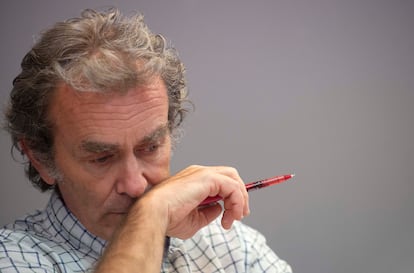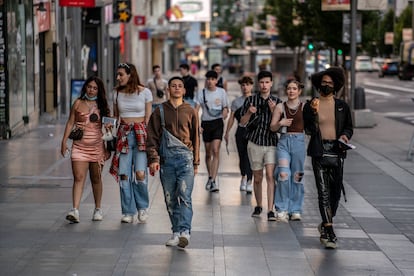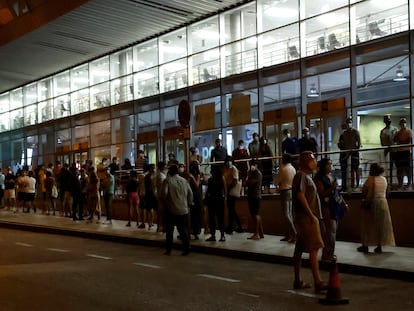Outlook for pandemic uncertain in Spain, as infections spread among young people and pressure on hospitals rises
Official coronavirus cases for the year so far already outnumber those that were registered during the whole of 2020


What is clearly a fifth wave of the coronavirus in Spain, albeit different from the previous ones, is now having an effect on hospital occupation. The number of Covid-19 patients receiving treatment in Spain has risen 9% in a week, accompanying the rise in new cases that has been seen for the last 10 days and that has pushed the 14-day cumulative number of coronavirus cases per 100,000 inhabitants up to 204 – a rise of 50 compared to Friday, according to the latest data from the central Health Ministry.
Monday’s report included 32,607 new infections and added 23 Covid-19 victims to the overall total. Since the pandemic hit Spain, 3,866,475 coronavirus cases have been diagnosed, while the official death toll stands at 80,934.
The cumulative incidence among those aged 20-29 is now 640 cases per 100,000 inhabitants, up 191 compared to Friday
The data from Monday shows that the Health Ministry has now registered more coronavirus cases for this year than in all of 2020. Between February of last year, when infections began to be registered, and December, the health authorities registered 1,928,265 infections. Since January 2021 to today, a total of 1,938,210 have been detected. That said, during the first months of the pandemic, the majority of cases went untested given a lack of capacity, meaning that it is unlikely that this year has exceeded the number of real infections for the first year of the health crisis.
The increase in infections is mostly being seen among youngsters in Spain: the cumulative incidence among those aged 20-29 is now 640 cases per 100,000 inhabitants, up 191 compared to Friday, and among adolescents, the rise in incidence from Friday has been 178 to a total of 584.
While these groups suffer fewer serious effects of the coronavirus, such a major rise in infections is having an effect on hospitals, which on Monday had a total of 2,723 Covid-19 patients – 228 more than a week ago – and 644 in intensive care units (ICUs) – 28 more than last Monday.

With no public data available on the age of those being hospitalized, it’s difficult to know whether this rise is due to young people becoming seriously ill or that patients from older groups – vaccinated or otherwise – are suffering the effects of the rise in transmission. While moving at a slower pace, infections are rising in all age groups and despite older people being nearly completely vaccinated against Covid-19, there is a percentage of the population whose immune system will not respond to the shots. According to the Carlos III Health Institute in Madrid, the vaccination campaign is helping to avoid 88% of hospitalizations in senior residences – but that still leaves 12% of residents who are vulnerable.
To this small percentage of vaccinated citizens who could still require hospital treatment in the case of infection, the 60-69 group must be added, given that just under half have their two vaccine doses. This is due to the fact that the majority have been given the Oxford-AstraZeneca vaccine, whose two injections are being spaced out anywhere from 10 to 12 weeks according to the Spanish vaccination strategy, despite the fact this time frame could have been brought down to three weeks according to the technical information for the medication.
The outlook is now uncertain. Never before has a wave of the coronavirus arrived with such a high proportion of the population protected: 26,5050,676 people (55.9% of Spanish residents) have now received at least one dose, while 19,135,448 people (40.3%) have got the full protection offered by the vaccines. Despite the uptick in hospital patients, the pressure on these healthcare centers is still at minimal levels. For ordinary beds, occupation stands at 2.26% of the total, while the figure rises to 6.73% in ICUs.
Speaking on Monday, Fernando Simón, the director of the Health Ministry’s Coordination Center for Health Alerts (CCAES), described these occupation levels as “acceptable”– i.e. they leave a considerable margin to deal with more sick people without capacity being impaired.
Monday’s report included 32,607 new infections and added 23 Covid-19 victims to the overall total
But the uncontrolled transmission of the virus could bring other problems with it. In the short term, the primary healthcare system could become overwhelmed, given that it is already facing a summer with minimum staffing levels. Speaking on Monday, Simón pointed out that the public healthcare system, which also is home to epidemiologists and contact tracers, “has been severely overloaded” non-stop since the pandemic first hit in March 2020. “Now, with the type of transmission and the age groups affected, this is even more so,” he explained.
In the medium term, serious cases could begin to rise, as is already being seen. While the vaccines considerably reduce the dangers of the fifth wave, the virus will continue to cause deaths. What’s more, greater transmission increases the probabilities of dangerous mutations that could cause more serious illness or be able to evade the effect of the vaccines, and the number of people who will end up suffering long Covid, an illness that can incapacitate sufferers for months with a variety of different symptoms, could also rise.
Simón said on Monday that Spain’s regions – which are in charge of their healthcare systems, vaccination drives and coronavirus restrictions – still have a margin to implement measures to control this wave. He was very clear as to where action must be taken: “We are all seeing where the outbreaks are taking place,” he explained. “They are places where a lot of people are coming together, and where not complying with control measures is easy. If these are interior spaces, the ease of transmission will be greater.” Simón also pointed to the efforts and sacrifices that young people have had to make during the pandemic.
Simón, the government’s most-visible face of the coronavirus crisis, on Monday ruled out a change to the recent relaxation of mask use – until a couple of weeks ago, they were obligatory even when outside; now their use is optional in exteriors provided people can social distance. He added that the group of experts from the Health Ministry and the regions in charge of the response to risk situations is already examining the situation to decide whether tougher measures need to be taken.
English version by Simon Hunter.









































